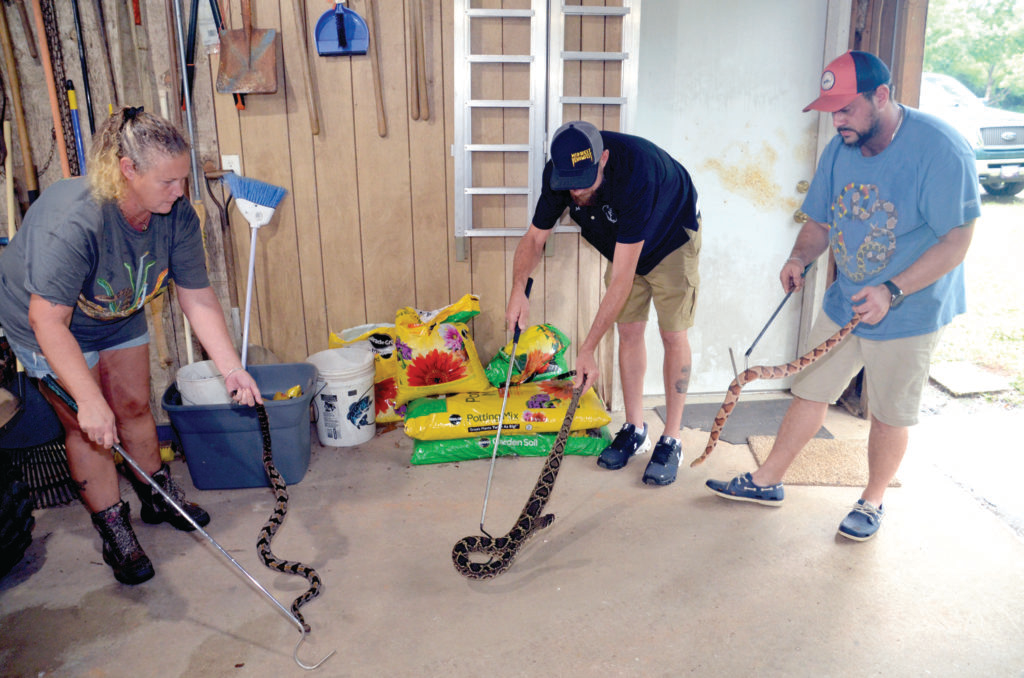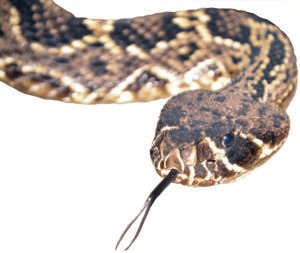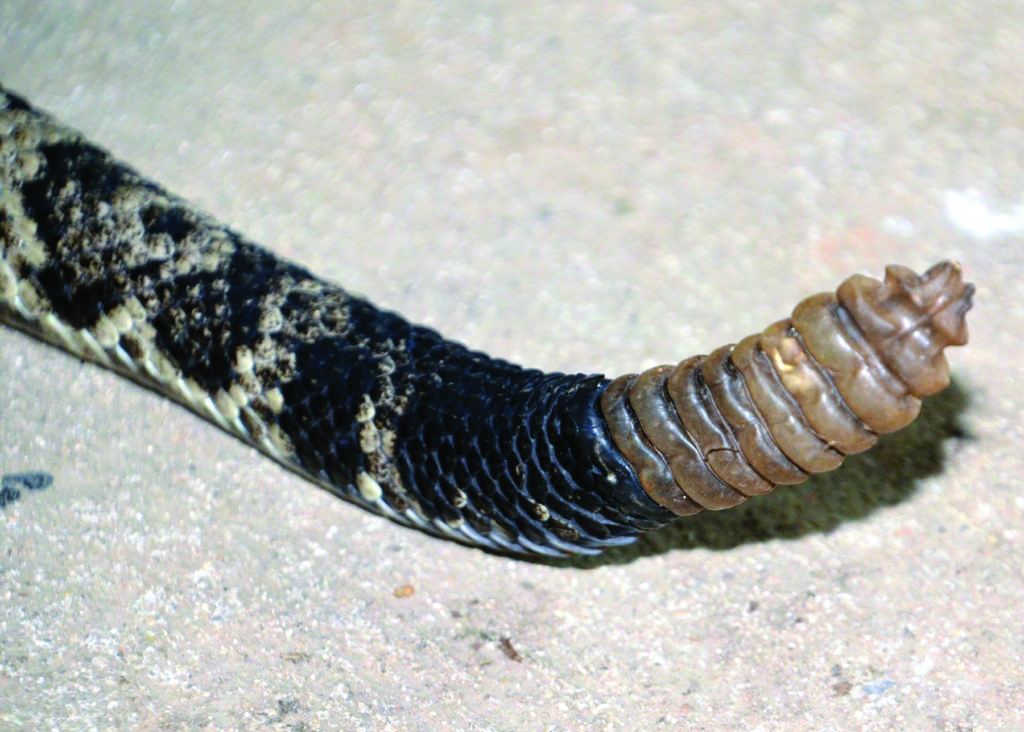Professional snake removers ‘educate, not eradicate’

Story and photos by John N. Felsher
Something slithering in the neighborhood? Who ya gonna call? (People under 40, ask your parents about the above reference.)
In 2013, longtime friends and reptile enthusiasts Mark Hay and Frankie Ferguson co-founded Alabama Snake Removers with the motto “Educate Not Eradicate.” They and their associates throughout the Cotton State respond when people call and want snakes removed from their properties. Someone from ASR will come to the property, safely remove the reptiles and relocate them elsewhere.
“Since we were children, we always had a passion for snakes,” says Ferguson, formerly from Childersburg, but currently residing in the Daphne area. “We decided to create something to help people who are scared of snakes. We also want to educate people on the importance of snakes and why they shouldn’t kill them. At the same time, we want to save the animals from a bad situation and release them back into the wild.”

Many people inherently fear snakes. Some people become almost hysterical when they see one. Some people theorize that this innate phobia dates all the way back to the serpent in the Garden of Eden. Others dislike snakes because they look creepy with no legs and can hide anywhere.
“There is a lot of fear about snakes, mainly because people lack education about the truth of snakes,” explains Hay, who is from Shelby County. “People tell a lot of old myths and stories passed down from generation to generation about snakes. For instance, some people think a cottonmouth will chase a person or a coachwhip can turn itself into a hoop and roll down a hill. Neither are true.”
More than 40 non-venomous snake species and six venomous ones call Alabama home. Venomous snakes can kill people, but that seldom happens. Both venomous and non-venomous snakes consume many vermin species, such as rats and mice that can carry diseases harmful to humans. King snakes kill and eat venomous snakes.
“Most snakes are non-venomous and harmless,” Hay says. “Venomous snakes can be very dangerous and shouldn’t be taken lightly. They should be given the respect they deserve. Snakes are native to Alabama and highly beneficial for a healthy ecosystem. Venom from different snakes can be used for medicines that treat many illnesses, such as some cancers. Copperhead venom is being researched to treat breast cancer. Some rattlesnake venom is in current heart medications.”
The largest and heaviest snake in Alabama, an eastern diamondback rattlesnake, can deliver a nasty bite that can kill or maim people. The biggest one on record measured 7.8 feet long and weighed 34 pounds. Alabamians might also encounter timber and pygmy rattlers. Cottonmouths, also called water moccasins, live in swamps, marshes, lakes, rivers, ponds and anywhere else they can find water. People could also see copperheads.
“In two weeks, I removed four adult rattlesnakes from a lady’s house,” recalls Hay, a housebuilder by trade. “On the second call to her house, she told me about a rattlesnake under her house. I crawled under the house and there wasn’t much room to maneuver under there. The snake got behind me and around my foot. I just caught movement in my peripheral vision. He wasn’t trying to sneak up on me to bite me. He just wanted to figure out an escape route. Luckily, I spotted him and caught him or that could have ended badly.”

The most venomous snake in Alabama and one of the rarest, eastern coral snakes grow to about 3.5 feet long. A relative of cobras, it can inject a potent neurotoxin that attacks the nervous system. Fortunately, few people encounter this colorful snake and even more rarely does one bite anyone. People often confuse these snakes with alternating yellow, black and red bands with similar looking non-venomous snakes. An old saying, “Red touch black, venom lack” would indicate a harmless snake. “Red touch yellow, kill a fellow” means a coral snake.
“Ever since I was a child, all I’ve ever wanted to do was to save snakes,” Ferguson says. “We do this because we love snakes and we’re tired of seeing them getting killed. We love animals and want to educate people on their importance. We want to keep snakes alive so future generations can see them.”
Helping homeowners
When Hay or others receive a snake call, they first try to identify the species. Most people, especially ones deathly afraid of all snakes, can’t tell the various species apart, but describing it can help the removers make a better removal plan. Handlers must take extra precautions with venomous snakes.
“Once we’re called, we recommend people keep an eye on the snake as best as they can, but from a safe distance,” Hay says. “We ask them to watch where the snake goes, but not chase it. If we know approximately where it was last spotted, we can find it quicker. The main thing is to keep safe. If the person doesn’t feel safe or comfortable, we can work other ways to get it.”

Hay will dispatch an associate closest to that snake, someone like Leslie Norris James from Semmes, to go capture the serpent. She started catching snakes at eight years old and now serves as the vice president of Reptile Education Awareness Conservation and Husbandry in Mobile. She regularly conducts reptile awareness shows to promote environmental education.
“I was always the crazy girl who played with snakes,” she says. “A lot of people won’t come in my house because I keep venomous snakes. My grandfather was deathly afraid of them and killed every snake that crossed his path. I started trying to get to them before he did. I wanted to move them to different places. I also want to educate people about our native snakes and how important they are to the ecosystem so they should not be killed. They’re so misunderstood and that fear is ingrained from generation to generation.”
Removers like James typically use hooked rods to catch snakes without harming them. They don’t hook into the snake, like someone gaffing a fish, or lasso it. Instead, they get the snake to rest on the hook so they can better control it.
“We slide the hook under the snake gently,” Ferguson says. “If we can get it by the tail and keep the hook under it, it will stay calm. We try to touch the snake with our hands as little as possible. If someone uses tongs to grab the snake, it’s immediately going to react defensively. I don’t ever want to pin a snake’s head down. If we find a venomous snake, we secure it in a proper container so we can safely relocate it to an area and release it away from people.”




